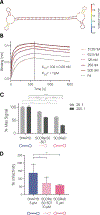SCORe: SARS-CoV-2 Omicron Variant RBD-Binding DNA Aptamer for Multiplexed Rapid Detection and Pseudovirus Neutralization
- PMID: 35972202
- PMCID: PMC9397568
- DOI: 10.1021/acs.analchem.2c01993
SCORe: SARS-CoV-2 Omicron Variant RBD-Binding DNA Aptamer for Multiplexed Rapid Detection and Pseudovirus Neutralization
Abstract
During the COVID-19 (coronavirus disease 2019) pandemic, several SARS-CoV-2 variants of concern emerged, including the Omicron variant, which has enhanced infectivity and immune invasion. Many antibodies and aptamers that bind the spike (S) of previous strains of SARS-CoV-2 either do not bind or bind with low affinity to Omicron S. In this study, we report a high-affinity SARS-CoV-2 Omicron RBD-binding aptamer (SCORe) that binds Omicron BA.1 and BA.2 RBD with nanomolar KD1. We employ aptamers SCORe.50 and SNAP4.74 in a multiplexed lateral flow assay (LFA) to distinguish between Omicron and wild-type S at concentrations as low as 100 pM. Finally, we show that SCORe.50 and its dimerized form SCOReD can neutralize Omicron S-pseudotyped virus infection of ACE2-overexpressing cells by >70%. SCORe therefore has potential applications in COVID-19 rapid diagnostics as well as in viral neutralization.
Figures




Similar articles
-
Omicron: A Heavily Mutated SARS-CoV-2 Variant Exhibits Stronger Binding to ACE2 and Potently Escapes Approved COVID-19 Therapeutic Antibodies.Front Immunol. 2022 Jan 24;12:830527. doi: 10.3389/fimmu.2021.830527. eCollection 2021. Front Immunol. 2022. PMID: 35140714 Free PMC article.
-
Evaluating the transmission feasibility of SARS-CoV-2 Omicron (B.1.1.529) variant to 143 mammalian hosts: insights from S protein RBD and host ACE2 interaction studies.Funct Integr Genomics. 2023 Jan 12;23(1):36. doi: 10.1007/s10142-023-00962-z. Funct Integr Genomics. 2023. PMID: 36631570 Free PMC article.
-
DNA aptamers inhibit SARS-CoV-2 spike-protein binding to hACE2 by an RBD- independent or dependent approach.Theranostics. 2022 Jul 18;12(12):5522-5536. doi: 10.7150/thno.74428. eCollection 2022. Theranostics. 2022. PMID: 35910791 Free PMC article.
-
Aptamer-based assembly systems for SARS-CoV-2 detection and therapeutics.Chem Soc Rev. 2024 Jul 1;53(13):6830-6859. doi: 10.1039/d3cs00774j. Chem Soc Rev. 2024. PMID: 38829187 Review.
-
Aptamer-engaged nanotherapeutics against SARS-CoV-2.Discov Nano. 2025 Apr 27;20(1):71. doi: 10.1186/s11671-025-04245-3. Discov Nano. 2025. PMID: 40289185 Free PMC article. Review.
Cited by
-
Rapid and Sensitive Detection of Inactivated SARS-CoV-2 Virus via Fiber-Optic and Electrochemical Impedance Spectroscopy Based Aptasensors.Biosensors (Basel). 2024 May 7;14(5):231. doi: 10.3390/bios14050231. Biosensors (Basel). 2024. PMID: 38785705 Free PMC article.
-
Programmable Nanostructures Based on Framework-DNA for Applications in Biosensing.Sensors (Basel). 2023 Mar 21;23(6):3313. doi: 10.3390/s23063313. Sensors (Basel). 2023. PMID: 36992023 Free PMC article. Review.
-
A Truncated Multi-Thiol Aptamer-Based SARS-CoV-2 Electrochemical Biosensor: Towards Variant-Specific Point-of-Care Detection with Optimized Fabrication.Biosensors (Basel). 2025 Jan 6;15(1):24. doi: 10.3390/bios15010024. Biosensors (Basel). 2025. PMID: 39852074 Free PMC article.
-
Nucleocapsid protein binding DNA aptamers for detection of SARS-COV-2.Curr Res Biotechnol. 2023;5:100132. doi: 10.1016/j.crbiot.2023.100132. Epub 2023 May 27. Curr Res Biotechnol. 2023. PMID: 37275459 Free PMC article.
-
RaptGen-Assisted Generation of an RNA/DNA Hybrid Aptamer against SARS-CoV-2 Spike Protein.Biochemistry. 2024 Apr 2;63(7):906-912. doi: 10.1021/acs.biochem.3c00596. Epub 2024 Mar 8. Biochemistry. 2024. PMID: 38457656 Free PMC article.
References
Publication types
MeSH terms
Substances
Supplementary concepts
Grants and funding
LinkOut - more resources
Full Text Sources
Other Literature Sources
Medical
Miscellaneous

